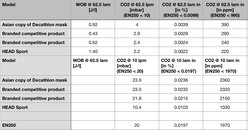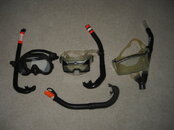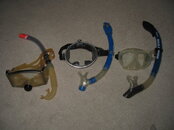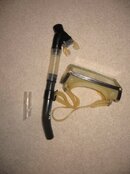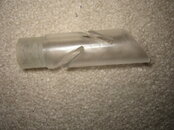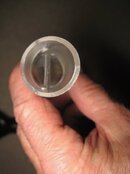I have done recently a lot of snorkel evaluation, and posted some of these
snorkel evals in the VSS website. I won't repeat here what is there, but the best snorkel for me is the Scubapro Shotgun snorkel, which I have been using continuously since the 1990s. The other I really like is the Aqualung Impulse snorkel. Neither of these snorkels are currently available, but they provide wave resistance without impairing breathing resistance. Baring that, I use the snorkels without purge valves a lot too. I find that clearing them is not a problem for me, as I started out on a "C" snorkel (yup, one with a pingpong ball), that I cut off into a J-snorkel. This was in the 1960s.
Here are some photos of the snorkels I evaluated:
This photo, which is an awful one of my face, shows the flexible Dacor snorkel from years ago, which I like a lot. Some flexible snorkels tended to fold over my chin in a high river current, cutting off the air supply, which for some reason got me to despise those snorkels. This one, while on a flex tube, will not fold over my chin.

This is a "L" snorkel, which has a mouthpiece which rotates to the desired position. I was hesitant to use it, and the first time I evaluated it did not like it because it was wet, even when I blew it hard. But what I determined was that this snorkel was designed to be on my right side, rather than on my left side of my face, because at the top the snorkel has a 90 degree turn. The first time I evaluated it, that 90 degree turn was pointed forward, toward the water, and would not clear the water correctly. When I wore it on my right side, it turned out to be a great snorkel. Although it is slightly smaller in diameter than my other snorkels, it did not seem to restrict my breathing.
The snorkel in my avitar is not my favorite. It has a non-return valve, which is nice, but also has restrictions on the end of the snorkel. You can see some of the snorkels and mask combinations I have evaluated below. The last three images are of the Aqualung snorkel, with its top removed. I found that it is just about an ideal height (top of my head) without the extension, and Aqualung has made it easy to remove this top too. While the top does prevent water from coming down, due to the two inclined planes inserted it the path of the water down the tube, with an outlet slit on the side, these noticeably increase the resistance to breathing, and I don't like it.
'Hope you enjoy these photos and my discussion of the snorkels. Please note that I carry a snorkel on my mask, or tucked away on my knife, on all dives. I don't have a folding snorkel, as I have all the snorkels I need. I get snorkels to evaluate from Goodwill, where they have a number of them very cheap (for those of you in the USA). Apparently, people buy these snorkels, then decide they are not into snorkeling after a trip to warm water, and give them away to Goodwill, where I can buy them for a few dollars.
SeaRat



